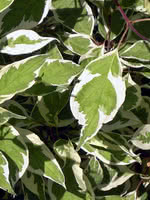Mon-Fri 9am - 5pm Mountain time
Western Snowberry vs Variegated Dogwood
Symphoricarpos occidentalis
Cornus alba argenteo-marginata
NOT AVAILABLE THIS SEASON - MIGHT RETURN
Like the Common Snowberry, the Western Snowberry is a small shrub with pink flowers useful for feeding livestock and preventing erosion. Unlike the common species, however, the Western Snowberry is much more suited to wet conditions, capable of persevering through poor soil drainage and occasional flooding.
After the Snowberry's flowers have bloomed, it produces berries which often last on the plant through winter. These berries are toxic to humans, but livestock and local wildlife love them! Those hoping to attract wildlife to their property can plant Snowberry and expect to see animals foraging on it much later in the year than other plants.
Variegated Dogwood is a small shrub that is often used in the first row of a shelterbelt, as a hedge, or for soil stabilization projects. It has the same distinctive red bark, white flowers, and berries as Red Osier Dogwood.
The key difference between the two is the leaves. Where Red Osier's leaves are green throughout, Variegated Dogwood has a white outline around each leaf, giving this shrub a distinctive look.
Western Snowberry Quick Facts
Variegated Dogwood Quick Facts
Toxicity: berries are toxic to humans

